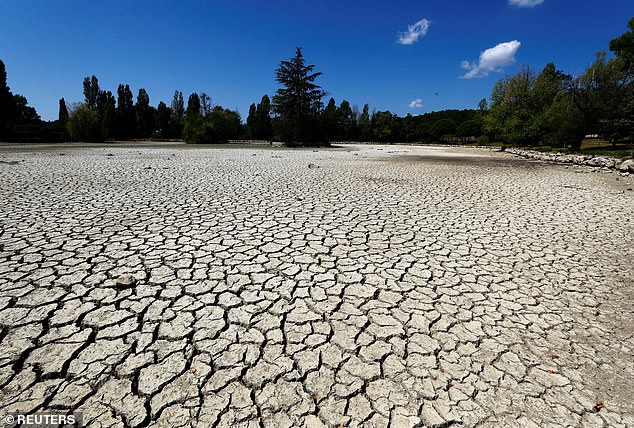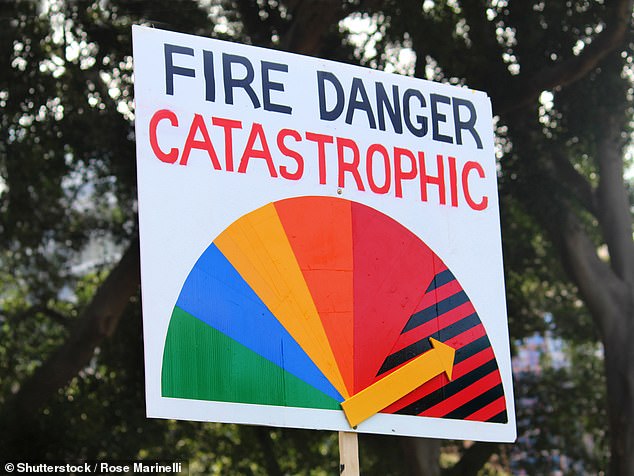Americans are being told to flush their toilets less as 48 states are under drought warnings after the driest spell in decades
The US is currently suffering its worst drought in 25 years, affecting all but two states.
About 257 million Americans are living under a severe drought warning as drier and warmer conditions swept the country last month, leaving only Alaska and Kentucky unaffected.
Several states have asked residents to reduce their water use by shortening shower times, not watering their lawns and flushing the toilet less to conserve resources. The situation in Pennsylvania was so dire that it led to the drying up of a lake and revealed the remains of some 200 waterfalls. year old bridge.
The hardest-hit areas include Texas, Ohio, West Virginia, Wyoming, Montana and Missouri – all of which are experiencing extreme or exceptional drought conditions after no rain since September.
Red alerts have been issued across the US as 14 major wildfires have burned more than 486,000 hectares in 10 states, including Oklahoma, Texas and Massachusetts.
Alaska and Kentucky have experienced drier conditions, but temperatures in Alaska have remained cooler than average, allowing the country to escape a moderate drought, while a cold front brought rain to Kentucky on Thursday.
Efforts to conserve water have been made in US states such as Colorado and Hawaii, while those in Pennsylvania have been asked to reduce their water use by 10 to 15 percent, which equates to 11 to 16 gallons per day.
This is because the drought covered only 12 percent of the US in June, but as of November that number has increased to 87 percent.
This was caused by a strong pressure ridge that remained high in the atmosphere for weeks, preventing precipitation from entering the region.
Most of the United States is experiencing a moderate to severe drought, with the exception of Alaska and Kentucky

The drought has led to fire bans and efforts to conserve water, after October was reported to be the driest month on record
The National Oceanic and Atmospheric Administration (NOAA) has described the event as a “flash drought” caused by lower-than-normal precipitation, abnormally high temperatures and high winds.
“While droughts usually develop slowly over months and years, a sudden drought intensifies rapidly over the course of a few weeks to a few months,” said Caily Schwartz, a scientist at the University of Alabama’s Global Water Security Center . .
According to the Southeast Regional Climate Center, at least 100 weather stations across the U.S. recorded no rain for the entire month of October.
The drought is ravaging major cities such as Philadelphia, Atlanta, Birmingham, Dallas, Las Vegas and Sacramento.
This even applies to states such as North Carolina and Georgia, which were hit by Hurricane Helene and were flooded with more than 5 meters of water at the end of September.
NASA’s Earth Observatory reported that many places hit by the hurricane dried out quickly and have not seen any precipitation since the natural disaster.
An extreme drought, also called D3, can disrupt agriculture and livestock production, increase the intensity and severity of forest fires and cause disease outbreaks such as typhoid and cholera when people drink contaminated water.
Exceptional droughts, called D4s, are the most severe because they not only have the same impact as a D3, but can also cause widespread crop failures, extreme water shortages and potential ecological devastation.
Affected areas also include New York City, where Mayor Eric Adams on Saturday urged residents to save every drop of water by reducing the number of times they flush the toilet, taking shorter showers and not leaving the water running while brushing teeth .
The warning comes as New York State reservoirs used by the city are now less than two-thirds full, down from the usual level of three-quarters this time of year.
The cotton industry has also been hit hard by the droughts and is expected to produce the second lowest yield in a decade.
This has especially affected Texas, which is the largest cotton producer in the entire country.
Farmers there are expected to produce only 2.1 million hectares of cotton this year, compared to 5.5 million hectares in 2022.
Arkansas was also hit, damaging much of the wheat their livestock need for grazing.

Severe to extreme droughts increase the risk of widespread fires across the country
“This fall was a prime example of sudden drought in parts of the U.S.,” said Jason Otkin, a meteorologist at the University of Wisconsin-Madison.
“These events can surprise people because you can quickly go from drought-free to severe drought.”
Wildfires have already started across the country, including in New Jersey, where firefighters battled two events last weekend.
One fire consumed more than 200 acres of land in Rockaway Township, forcing helicopters to drop hundreds of gallons of water in an attempt to extinguish the blaze.
A second fire broke out in Downe, New Jersey on Thursday, consuming 300 acres of land.
National Weather Service forecasters also warned states in the Northeast, including Connecticut, Pennsylvania and Massachusetts, of elevated fire conditions.
A 2023 study published in Science revealed that droughts have increased rapidly since the 1950s due to human-induced climate change from an increase in fossil fuels.
“In general, climate change is making all weather patterns more extreme,” Dr. Rohit T. Aggarwala, New York City’s chief climate officer and commissioner of the Department of Environmental Protection. The New York Times.
He said that while the Northeast is likely to experience wetter conditions heading into the winter months, “we also have a high chance of shorter, more extreme droughts like the one we are in now.”
